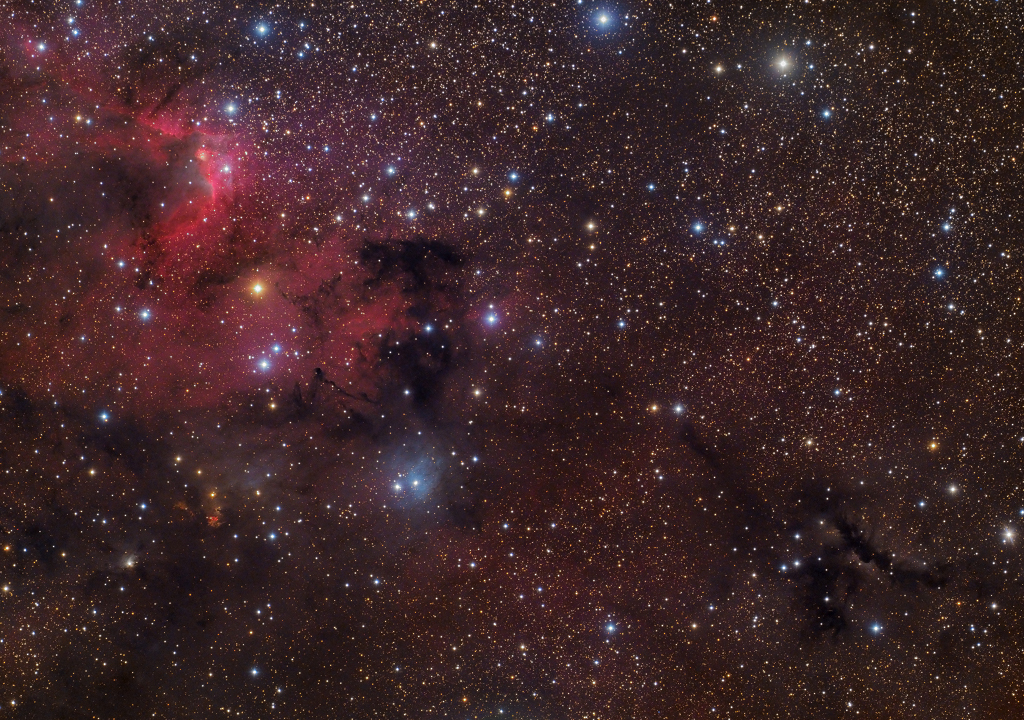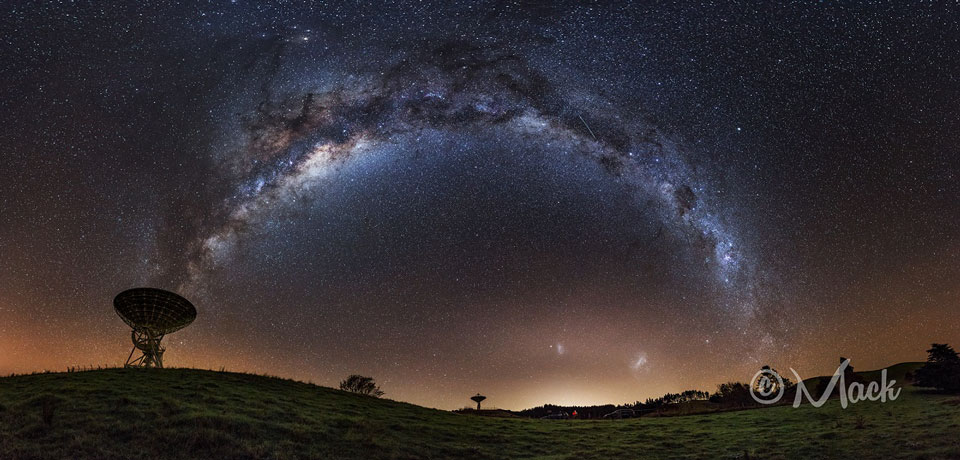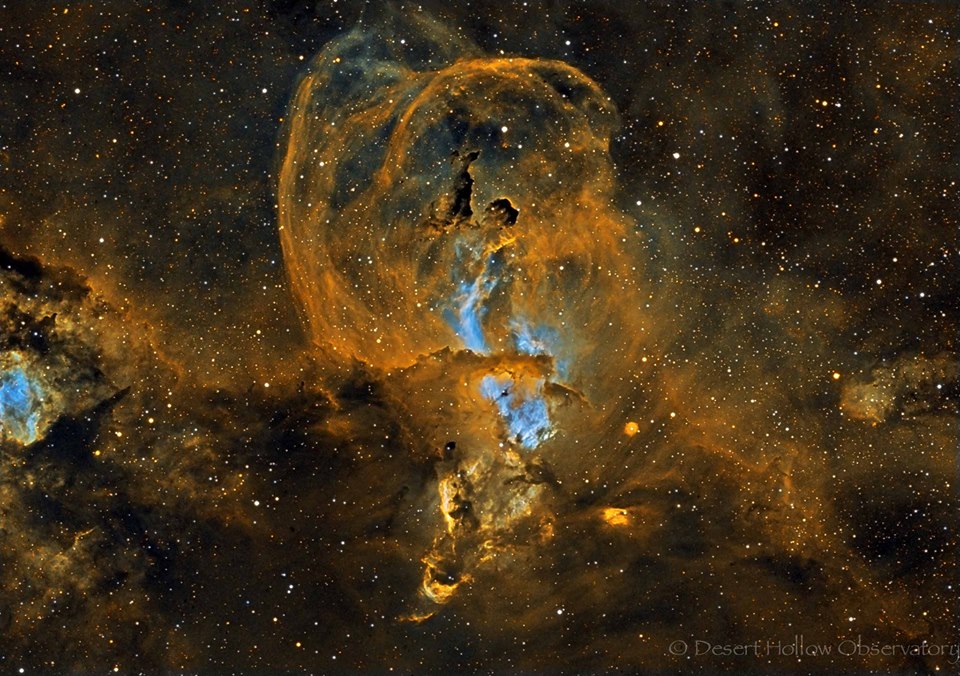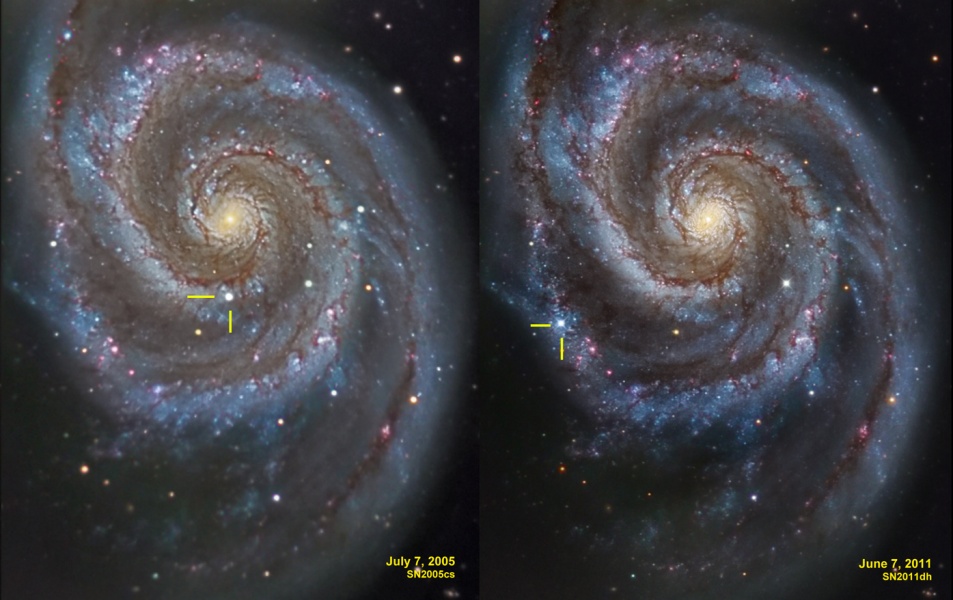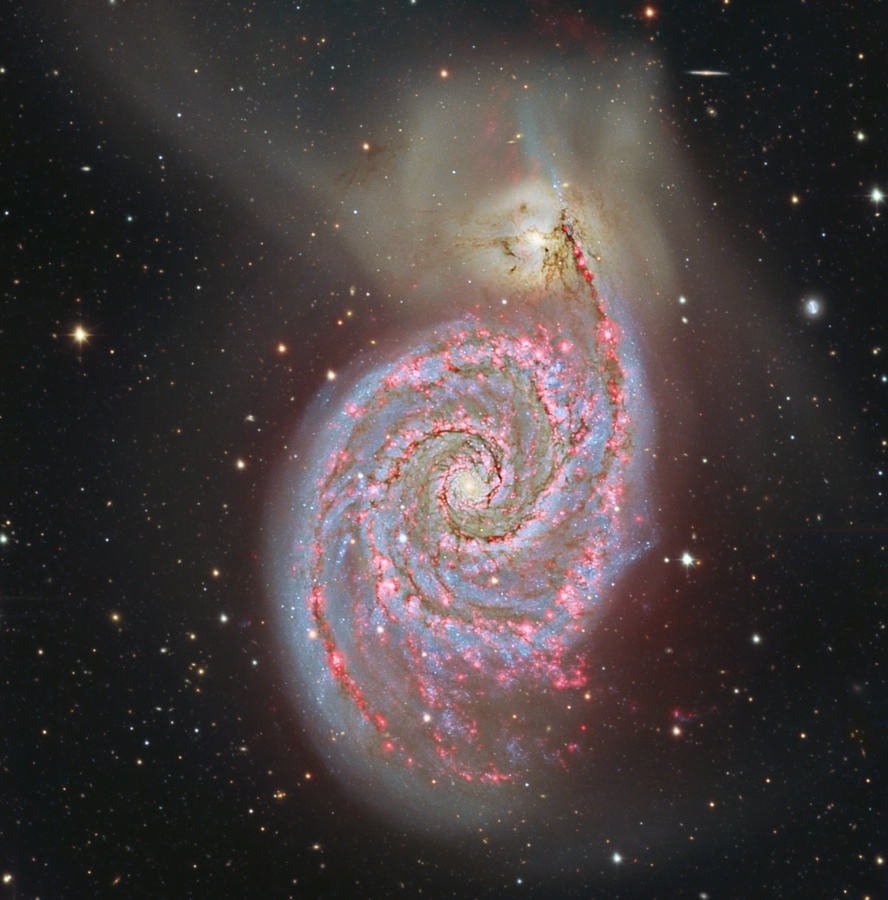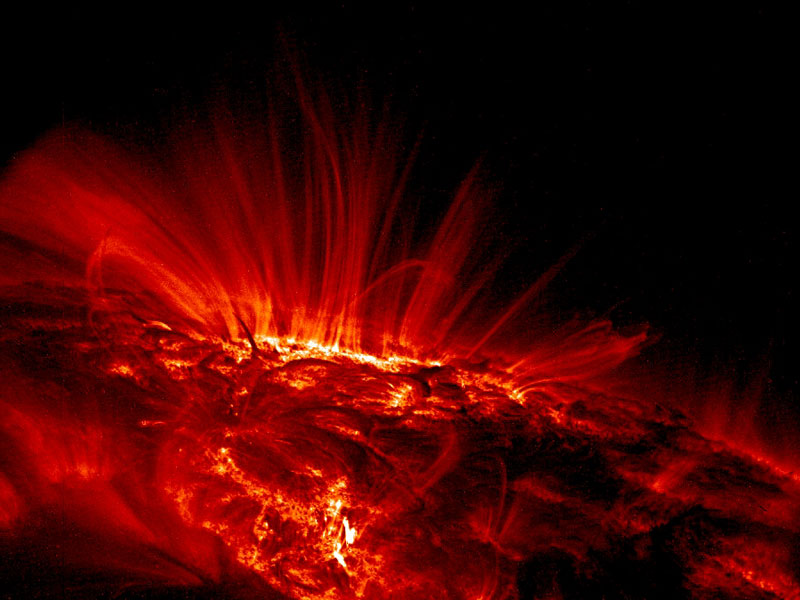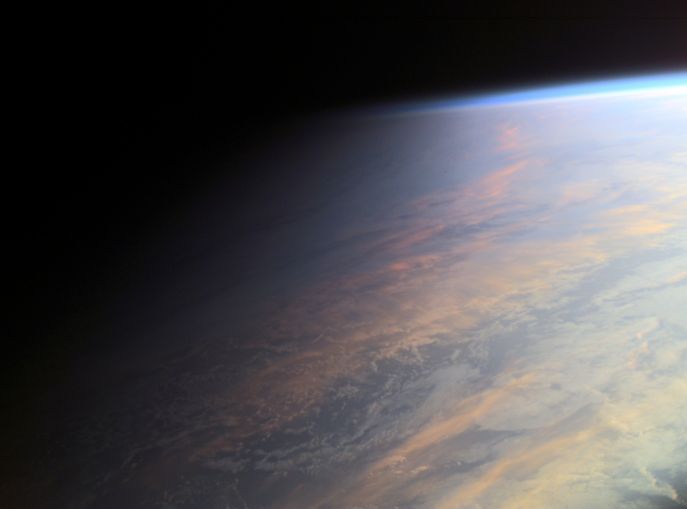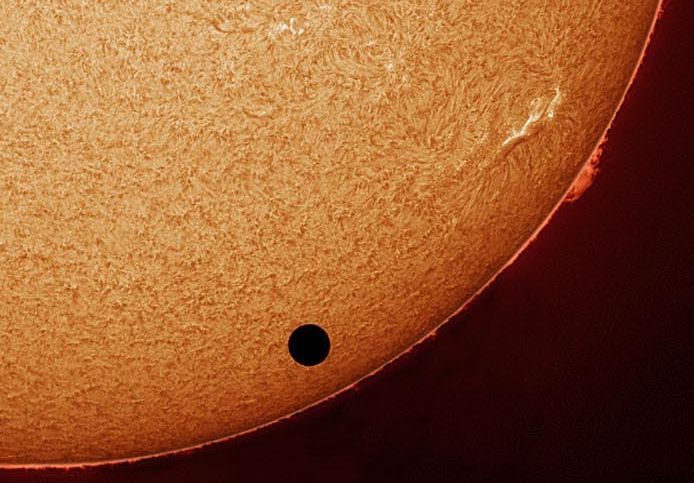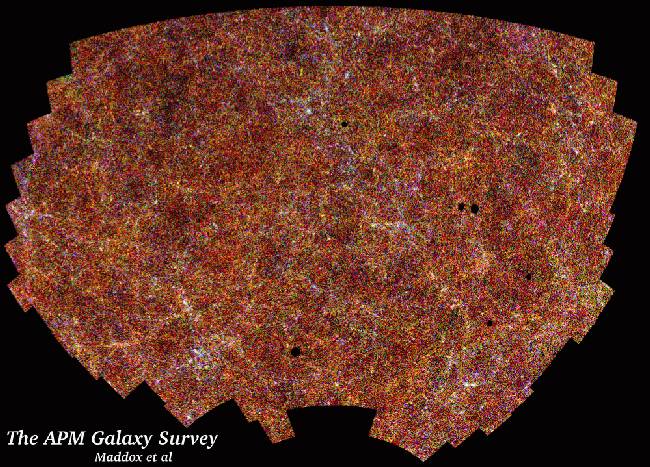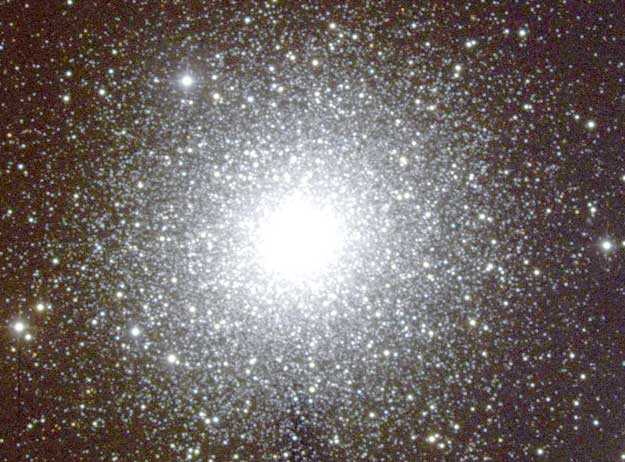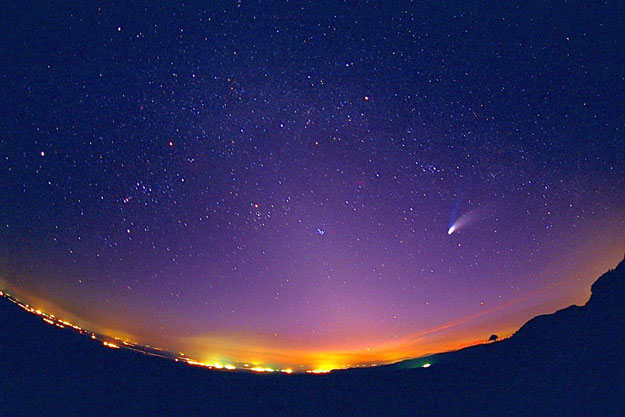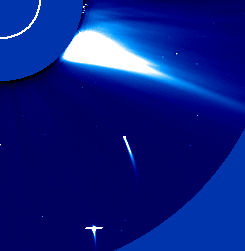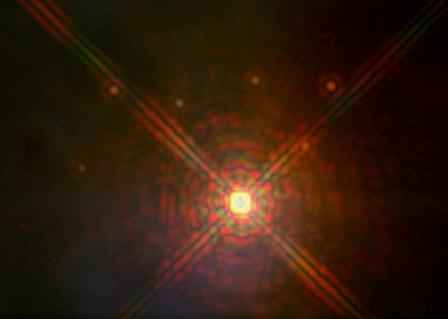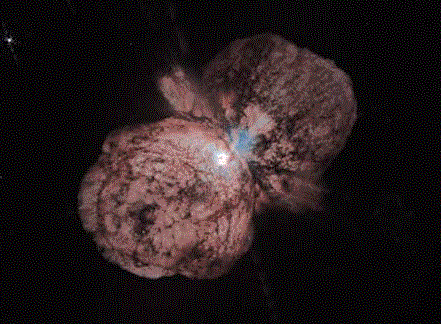| << Previous | Index | Next >> |
2015 This colorful skyscape spans about three full moons (1.5 degrees) across nebula rich starfields along the plane of our Milky Way Galaxy in the royal northern constellation Cepheus. Near the edge of the region's massive molecular cloud some 2,400 light-years away, bright reddish emission region Sharpless (Sh) 155 lies at the upper left, also known as the Cave Nebula. About 10 light-years across the cosmic cave's bright rims of gas are ionized by ultraviolet light from hot young stars. Dusty blue reflection nebulae also abound on the interstellar canvas cut by dense obscuring clouds of dust. The long core of the Lynds Dark Nebula (LDN) 1210 anchors the scene at lower right. Astronomical explorations have revealed other dramatic signs of star formation, including the bright red fleck of Herbig-Haro (HH) 168. Directly below the bright Cave Nebula, the Herbig-Haro object emission is generated by energetic jets from a newborn star.
2014 No, radio dishes cannot broadcast galaxies. Although they can detect them, the above image features a photogenic superposition during a dark night in New Zealand about two weeks ago. As pictured above, the central part of our Milky Way Galaxy is seen rising to the east on the image left and arching high overhead. Beneath the Galactic arc and just above the horizon are the two brightest satellite galaxies of our Milky Way, with the Small Magellanic Cloud to the left and the Large Magellanic Cloud on the right. The radio dish is the Warkworth Satellite Station located just north of Auckland.
2013 What's happening in the NGC 3582 nebula? Bright stars and interesting molecules are forming. The complex nebula resides in the star forming region called RCW 57. Visible in this image are dense knots of dark interstellar dust, bright stars that have formed in the past few million years, fields of glowing hydrogen gas ionized by these stars, and great loops of gas expelled by dying stars. A detailed study of NGC 3582, also known as NGC 3584 and NGC 3576, uncovered at least 33 massive stars in the end stages of formation, and the clear presence of the complex carbon molecules known as polycyclic aromatic hydrocarbons (PAHs). PAHs are thought to be created in the cooling gas of star forming regions, and their development in the Sun's formation nebula five billion years ago may have been an important step in the development of life on Earth. The above image was taken at the Desert Hollow Observatory north of Phoenix, Arizona, USA.
2012
Click to play embedded YouTube video.
Credit: Solar Dynamics Observatory, SVS, GSFC, NASA; Music: Requiem for a Dream (Clint Mansell)
2011 Where do spiral galaxies keep their supernovae? Near their massive star forming regions, of course, and those regions tend to lie along sweeping blue spiral arms. Because massive stars are very short-lived, they don't have a chance to wander far from their birth place. Remarkably, in the last 6 years two Type II supernovae, representing the death explosions of massive stars, have been detected in nearby spiral M51. Along with a third supernova seen in 1994, that amounts to a supernova bonanza for a single galaxy. As demonstrated in these comparison images, SN2005cs, the supernova discovered in 2005, and more recently SN2011dh, the exceptionally bright supernova first recorded just last month, both lie along M51's grand spiral arms. Perhaps the original spiral nebula, M51 is also known as the Whirlpool Galaxy.
2010
2009 A sea of clouds laps at rugged mountain peaks of the French Pyrenees in this serene view from Pic du Midi Observatory. The time exposure was recorded on June 4, with the constellations Sagittarius and Scorpius shining in the starry night. At the top right lies a faint, but colorful moondog or paraselene. Analogous to a sundog or parhelion, the paraselene is produced by moonlight shining through thin, hexagonal-shaped ice crystals in high cirrus clouds. As determined by the ice crystal geometry, a bright gibbous Moon illuminates the scene from beyond the picture's right edge, 22 degrees from the lovely paraselene.
2008 What's the world's most complex space robot doing up there? Last week, Dextre was imaged moving atop the Destiny Laboratory Module of the International Space Station (ISS), completing tasks prior to the deployment of Japan's Kibo pressurized science laboratory. Dextre, short for the Canadian-built Special Purpose Dextrous Manipulator, has arms three meters in length and can attach power tools as fingers. Behind Dextre is the blackness of space, while Earth looms over Dextre's head. The Kibo laboratory segment being deployed during space shuttle Discovery's trip to the ISS can be pressurized and contains racks of scientific experiment that will be used to explore many things, including how plants brace themselves against gravity, and how water might be inhibited from freezing in cells under microgravity.
2007
2006 It was a quiet day on the Sun. The above image shows, however, that even during off days the Sun's surface is a busy place. Shown in ultraviolet light, the relatively cool dark regions have temperatures of thousands of degrees Celsius. Large sunspot group AR 9169 is visible as the bright area near the horizon. The bright glowing gas flowing around the sunspots has a temperature of over one million degrees Celsius. The reason for the high temperatures is unknown but thought to be related to the rapidly changing magnetic field loops that channel solar plasma. Sunspot group AR 9169 moved across the Sun during 2000 September and decayed in a few weeks.
2005 No sudden, sharp boundary marks the passage of day into night in this gorgeous view of ocean and clouds over our fair planet Earth. Instead, the shadow line or terminator is diffuse and shows the gradual transition to darkness we experience as twilight. With the Sun illuminating the scene from the right, the cloud tops reflect gently reddened sunlight filtered through the dusty troposphere, the lowest layer of the planet's nurturing atmosphere. A clear high altitude layer, visible along the dayside's upper edge, scatters blue sunlight and fades into the blackness of space. This picture actually is a single digital photograph taken in June of 2001 from the International Space Station orbiting at an altitude of 211 nautical miles.
2004 Enjoying the 2004 Transit of Venus from Stuttgart, Germany, astronomer Stefan Seip recorded this fascinating, detailed image of the Sun. Revealing a network of cells and dark filaments against a bright solar disk with spicules and prominences along the Sun's limb, his telescopic picture was taken through an H-alpha filter. The filter narrowly transmits only the red light from hydrogen atoms and emphasizes the solar chromosphere -- the region of the Sun's atmosphere immediately above its photosphere or normally visible surface. Here, the dark disk of Venus seems to be imitating a giant sunspot that looks perhaps a little too round. But in H-alpha pictures like this one, sunspot regions are usually dominated by bright splotches (called plages) on the solar chromosphere.
2003 Our universe is filled with galaxies. Galaxies -- huge conglomerations of stars, gas, dust -- and mysterious dark matter are the basic building blocks of the large-scale universe. Although distant galaxies move away from each other as the universe expands, gravity attracts neighboring galaxies to each other, forming galaxy groups, clusters of galaxies, and even larger expansive filaments. Some of these structures are visible on one of the most comprehensive maps of the sky ever made in galaxies: the APM galaxy survey map completed in the early 1990s. Over 2 million galaxies are depicted above in a region 100 degrees across centered toward our Milky Way Galaxy's south pole. Bright regions indicate more galaxies, while bluer colors denote larger average galaxies. Dark ellipses have been cut away where bright local stars dominate the sky. Many scientific discoveries resulted from analyses of the map data, including that the universe was surprisingly complex on large scales.
2002 From afar, the whole thing looks like an Eagle. A closer look of the Eagle Nebula, however, shows the bright region is actually a window into the center of a larger dark shell of dust. Through this window, a brightly-lit workshop appears where a whole open cluster of stars is being formed. In this cavity tall pillars and round globules of dark dust and cold molecular gas remain where stars are still forming. Already visible are several young bright blue stars whose light and winds are burning away and pushing back the remaining filaments and walls of gas and dust. The Eagle emission nebula, tagged M16, lies about 6500 light years away, spans about 20 light-years, and is visible with binoculars toward the constellation of Serpens. The above picture combines three specific emitted colors and was taken with the 0.9-meter telescope on Kitt Peak, Arizona, USA.
2001 Beneath the south pole of our Milky Way Galaxy lies a ball of over 100,000 stars. M2, the second object on Charles Messier's eighteenth century list of bright diffuse sky objects, is known as a globular cluster, and orbits the center of our Galaxy like nearly 200 other globular clusters left over from the early days of our universe. M2, pictured above, spans over 150 light-years, lies about 50,000 light-years away, and can be seen with binoculars towards the constellation of Aquarius. Determining the distances and ages to globular clusters like M2 constrains the scale and age of our entire universe.
2000 Sirius is the brightest star in the night sky. Sirius is visible on the far left of the above photograph, to the left of the constellation of Orion and Comet Hale-Bopp. Intrinsically, Sirius is over 20 times brighter than our Sun and over twice as massive. As Sirius is 8.7 light years distant, it is not the closest star system - the Alpha Centauri system holds this distinction. Sirius is called the Dog Star because of its prominence in the constellation of Canis Majoris (Big Dog). In 1862, Sirius was discovered to be a binary star system with a companion star, Sirius B, 10,000 times dimmer than the bright primary, Sirius A. Sirius B was the first white dwarf star discovered, a type of star first understood by Subrahmanyan Chandrasekhar in 1930. While studying Sirius in 1718, Edmond Halley discovered that stars move with respect to each other. There is conflicting evidence that Sirius appeared more red only 2000 years ago.
1999 This enhanced Hubble Space Telescope image shows in remarkable detail the inner portion of the disk of dust and gas surrounding the star AB Aurigae. Knots of material, visible here for the first time, may well represent an early stage of a process which could result in the formation of planets over the next few million years. AB Aurigae is a young star (2-4 million years old), about 469 light-years distant. Its swirling circumstellar disk is large, about 30 times the size of our solar system. Astronomers believe planet-making is just beginning in AB Aurigae's disk because known disks surrounding younger stars (less than 1 million years old) do not show such clumpy structure, while disks of slightly older stars (aged 8-10 million years) have gaps and features suggesting that planets have already been formed. Why the window pane appearance? Wide black stripes in the picture are caused by occulting bars used to block out the overwhelming starlight and the diagonal streaks are due to diffraction spikes.
1998 his four frame animation (courtesy D. Biesecker) shows two comets arcing toward a fatal fiery encounter with the Sun. These discovery images were recorded by the LASCO instrument on board the space-based SOHO solar observatory on June 1-2. A portion of LASCO's circular occulting disk - which blocks the blinding direct sunlight - is seen at the upper left along with a bright solar wind region extending to the right. For scale, the size and position of the Sun's edge are outlined by the white quarter circle on the occulting disk. The Sungrazer comets approach from below and have visible tails. The lower comet's coma is bright enough to cause a horizontal blemish in the digital image, while the tail of the upper comet grows dramatically as it closes with the Sun. The pair are "twins" or at least "siblings" in the sense that they are both likely members of a family of comets thought to result from the breakup of a single large parent comet. Members of the Sungrazer family can pass within 400,000 miles or less of the solar surface and many, like this pair, do not survive.
1997 The star cataloged as NGC2264 IRS is normally hidden from the inquiring gaze of optical telescopes. It resides in the midst of the obscuring gas and dust of a nearby star forming region popularly known as the Cone Nebula. Imaged in penetrating infrared light by the Hubble Space Telescope's newly operational NICMOS instrument, this young and massive star was found to be surrounded by six "baby" sun-like stars - all within less than a tenth of a light-year of their "big brother". The diffraction spikes and rings surrounding big brother are image artifacts. Astronomers believe that the high speed winds generated by the massive star compressed nearby material causing the formation of the smaller stars in a text book example of triggered star formation. The newly created suns appear to lie along an otherwise invisible boundary where the high speed gas has collided with the wall of a denser molecular cloud. NGC2264 IRS also seems to be the source of the outflow which created the striking cone shape of the optical nebula.
1996
| << Previous | Index | Next >> |
